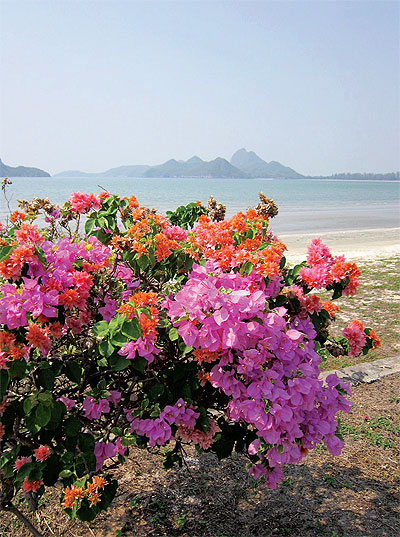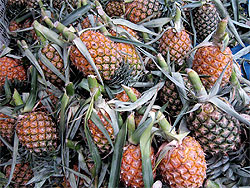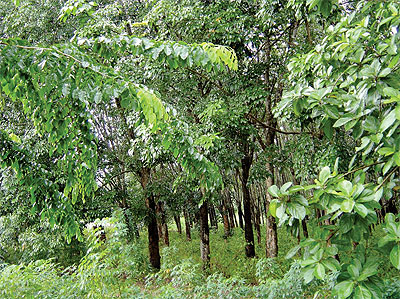After reading about mulberry and its many health benefits in Green Fingers recently, Kanneegar Pindavanija came upon the idea of promoting it as a supplementary cash crop for rubber plantation or orchard growers. “While waiting for their rubber or fruit trees to grow, agriculturists can plant mulberry between the trees and earn money from either harvesting their fruit or leaves,” she wrote. Ms Kanneegar wants to know where saplings for such a purpose can be bought cheaply.

Ornamental: Grafting makes it possible for gardeners to develop bougainvillea which bear flowers of different colours.
Rubber tree growers in the South plant pineapples as a cash crop while their newly planted trees are growing. Nine to 10 months after planting, the pineapples can be forced to bear flowers, and fruit can be harvested seven months later. The stomata, or tiny pores on the surface of leaves where gases are absorbed and released, of most plants are open during the day but those of pineapples open at night. Spraying the plants with flower-forcing hormone at dusk or before the sun rises, therefore, is more effective than when it is done during the day.
The pineapples have pups, and these can be made to bear flowers for additional yields in the years that follow. By the fourth or fifth year the rubber trees will have been too big and shading the pineapple plants. Like fruit trees, the pineapple needs full sun to bear fruit, so the pups are harvested and either sold to other growers or planted elsewhere.
Planting mulberry is a novel idea. Usually, saplings sold by nurseries have been propagated by air layering or grafting from trees that are already bearing fruit. With fertiliser and proper care, fruit can be harvested from year one to the fourth or fifth year until the plants are shadowed by the growing trees. In the shade the mulberry plants will not be productive where fruit is concerned, but their leaves can still be harvested and made into tea. But why confine the mulberry to just a supplementary cash crop? Why not set aside a small portion of the land for mulberry alone? One rai of land can accommodate several trees planted two metres apart. Grown in good soil and in full sun, mulberry trees can be a perennial source of income as they grow older and bigger.

Good yield: On plantations in the South, pineapples are one of the most popular supplementary cash crops.
Mulberry saplings for large-scale plantation, however, are not readily available, unlike pineapple pups which can be bought by the hundreds and even thousands. Although several plant nurseries were selling mulberry at the recent Kaset Fair, if you wish to plant by the hundreds you can hardly find a nursery with that many in stock. What’s more, selling for 80 to 250 baht each, the saplings can be way too expensive for the ordinary orchard grower. What enterprising agriculturists do is buy a few plants and grow these until they are big enough to be propagated. Through air layering, one large tree can be divided into several trees.
Air layering, also known as marcotting, is a form of asexual reproduction in which the stem of a woody species is encouraged to develop roots.
This is done by removing a ring of bark, including the cambium layer, below a node about 15cm from the tip. The portion from which the ring of bark has been removed is enclosed with moist sphagnum moss or coir dust, then wrapped with clear plastic or polyethylene film tied on each end with a string. When sufficient roots have developed inside the plastic wrapper, the rooted stem is cut from the mother plant and grown as a new plant.
Air layering is one of the most common ways of propagating ornamental plants such as croton, hibiscus and most of the Mussaenda cultivars. It is also used to produce a new crop of young, well-proportioned foliage plants from old ones that have too much stem or grown too tall or lanky. However, although many fruit trees can be easily propagated by air layering, it is not commonly practised as the plants have no tap roots. Trees without tap roots can be easily uprooted by a strong wind or can easily succumb to lack of water. Many mango trees died during the great floods that submerged many provinces, including Bangkok, for months in 2011. Those that survived were believed to have been grown from seeds and therefore had tap roots.
The method commonly used in propagating fruit trees, including mulberry, is grafting. It is done by joining the stems of two plants in such a manner that they unite and continue to grow as one plant. The upper part of the combination is called scion and the lower part is the rootstock, known simply as stock. By grafting the stem of a fruit-bearing tree on a stock grown from seed, you develop a young and vigorous tree that readily bears fruit.
Grafting is the method used in perpetuating clones while ensuring their health through the use of stocks tolerant to root rot and virus diseases. It is used for fruit trees as well as ornamental plants like plumeria and bougainvillea. Through grafting, gardeners develop bougainvillea plants with multi-coloured flowers.
Meanwhile, Mike Isenstadt, wrote to say that he had been enjoying mulberry since he was a child on his grandfather’s farm in the US. Now he is tired of seeing the fruit in small plastic boxes in supermarkets, and wants to know if there are other ways of selling it. “Lots of trees and the fruit going to waste up here in the North,” he wrote. He added that he is moving soon to Trang and wants to know if he can grow mulberry trees there.
Of course mulberry can be grown in Trang province, or anywhere in Thailand. As the fruit is perishable, one of the ways it can be transported long distances and sold is by making it into jam. I find it lasts for several months when cooked in syrup and stored in the freezer for later use as a filling for cheesecake and muffins in lieu of tinned or frozen blueberry. In the future, if Ms Kanneegar is successful in promoting mulberry as a supplementary cash crop for rubber and orchard tree growers, we may be able to purchase mulberry fruit juice in bottles or cans in supermarkets or enjoy mulberry-flavoured ice-cream.
As for me, I find it is best eaten fresh off the tree or as a smoothie.
Email nthongtham@gmail.com.

Temporary: Supplementary crops are viable only when the rubber trees are newly planted and the underlying crop can catch the full sun.

